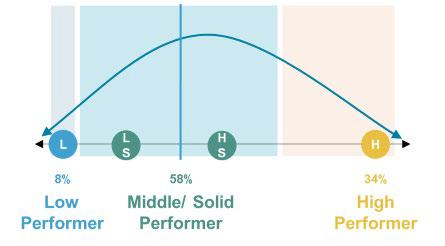High Solid Performer Support





Who Are High Solid Performers?
Middle/solid performers constitute about 60-70% of employees, making them the backbone of every organization. While, this group positively contributes to overall results, they benefit greatly from specific coaching and support relevant to their performance level. The middle/solid performance level can be further divided into two levels for more specific support: High Solid & Low Solid.

High solid performers want to build relationships with their leaders, have opportunities for professional development, and hear feedback that inspires improvement. When high solids are properly coached, they can become high performers, and low solids can become high solids and so on. Identifying who falls into each performance level enables leaders the opportunity to support and develop each employee for individual career success.
Characteristics of High Solid Performers:
- influenced by high performers
- adopt best practices
- are willing to update leadership skills and increase knowledge
- achieve goals
- live in & out of company values, want to continue to improve and may need coaching and direction
- contribute by identifying problems; yet are not confident in solutions
Developing High Solid Performers
When you communicate with high solids effectively, a relationship is built that will retain, motivate, and inspire your direct reports. People want to know they are valuable and understand how they contribute to results. A connection to their leader helps these individuals build confidence and instills the drive needed to exceed goals.
Solid performers need support from their leader to breakdown organizational goals, identify leadership skills and opportunities for improvement, and increase their overall performance level. While providing feedback to improve performance remember to mind the 3:1 positive to negative ratio and focus on developing one area at a time. Celebrate the small wins as they gradually lead to the big wins.
It’s a good idea to prepare for performance conversations by practicing with a colleague or completing a conversation guide with the key words you plan to use. Think about a specific high solid performer you supervise while reviewing the structure of this coaching conversation. Think about how you could engage in a similar conversation with your employee.
| SUPPORT | Begin a conversation with a high solid performer, by relieving their anxiety. It’s likely this person is feeling anxious about meeting with their leader, and they will be more receptive once we put them at ease. |
“Hello Ms. Calahagn, please come in. As you know we are going to talk with each other about the results of my observations concerning your performance. You are such an important employee of the Transportation Department. I want to spend some time talking with you about your value as an employee in this school district.” |
| RECOGNIZE | Next, we recommend identifying one skill or area the high solid executes well. Take time to recognize their performance in this area and continue the conversation by explaining why their performance is important to the organization. |
“You are appreciated for the service excellence you exhibit each day with phone calls from customers and walk ins as well. You realize that everyone is our customer. You are knowledgeable about routes and you always try to help the customer. You are an important member of our team.” |
| DEVELOP WITH INPUT | Now, let’s engage the employee in a collaborative conversation to support their professional development. Start first with what’s right and work from positive behaviors to help employees grow. By asking probing questions, we gain insight from our employees on behaviors that lead to results. This becomes a reflective, engaging conversation people look forward to having with their leader. Now our high solid employee is open and appreciative of our suggestions. |
“Tell me three things you’re doing right now that make you feel good about your performance. Why is this working for you? Can you recall a recent obstacle that is affecting your ability to achieve results? Why is this a barrier? Can you think of a time you worked through a similar barrier? What did you do? What ideas do you have for working through this barrier? |
| SUPPORT | We close the conversation by talking about what they do well and reinforcing the fact that you want to retain them. Ask what you can do to support them to continue to grow and develop. |
“What can I do to help you continue to make a difference for our department, your team, and the organization? I want to do what you need me to do to continue to make your job worthwhile and productive.” |
4 Steps to a High Solid Performance Conversation:
Support
- A high solid performer is likely anxious, our goal is to begin the conversations by calming the individual’s anxieties and assuring them that this will be a positive conversation.
- Describe the good qualities about their performance.
Recognize
- Express a specific area or situation they performed well in and why this performance is important for the organization.
Develop with Input
- Ask the high solid, “What is one thing they would like to improve to continue to grow and develop to reach their highest performance potential?”
- Continue to ask probing questions and work together to determine the best approach.
Support
- Reinforce that you want to retain them.
- Ask what you can do to support their growth and professional development.





